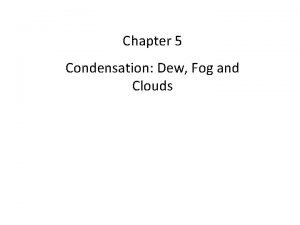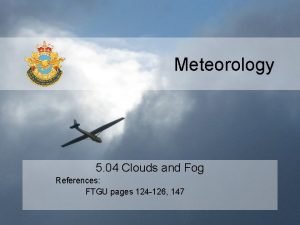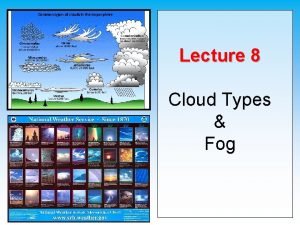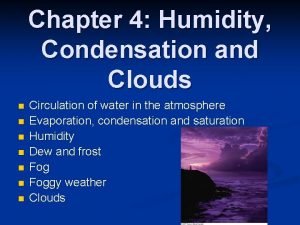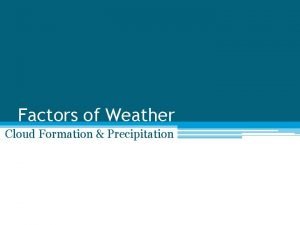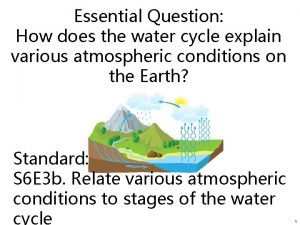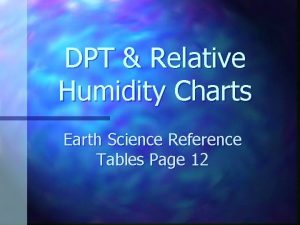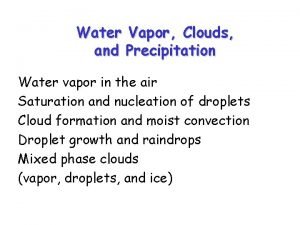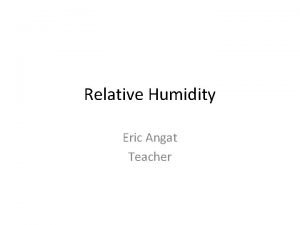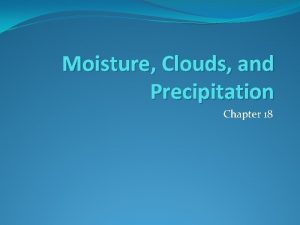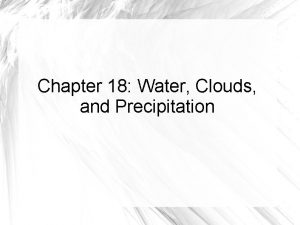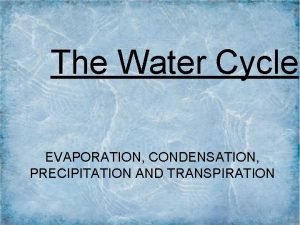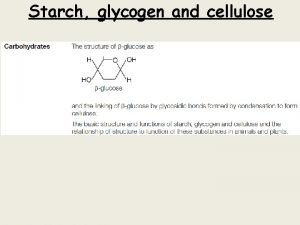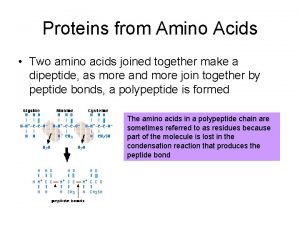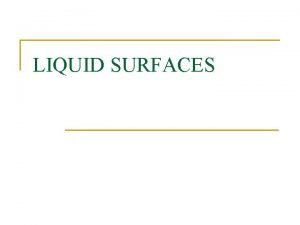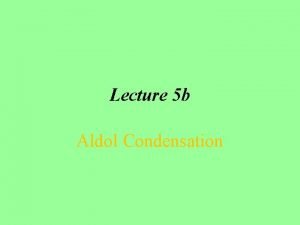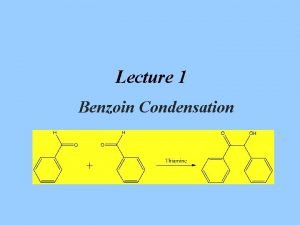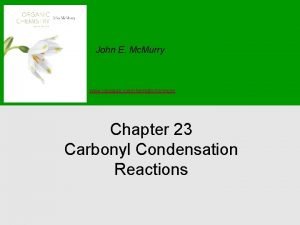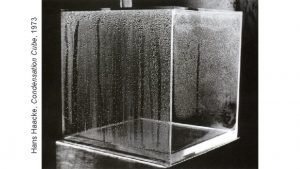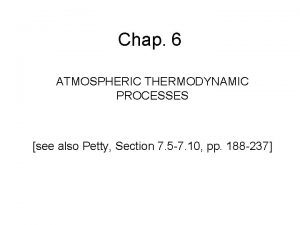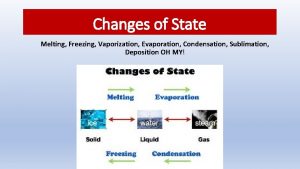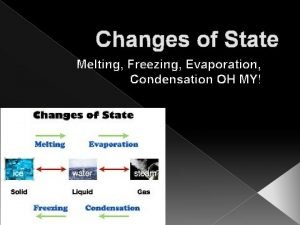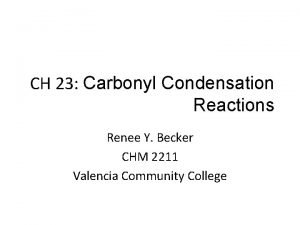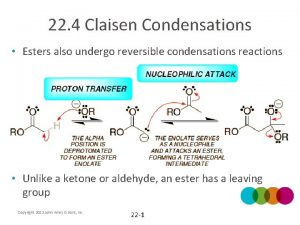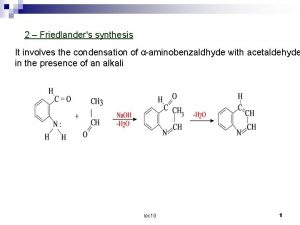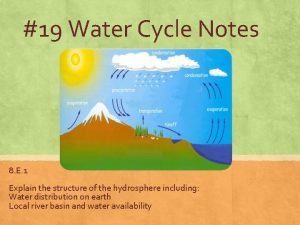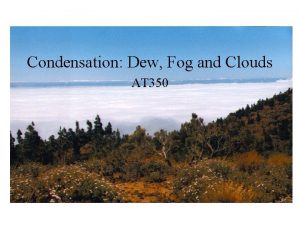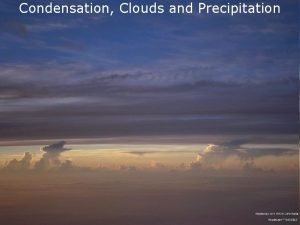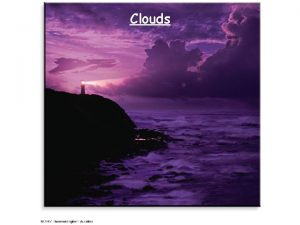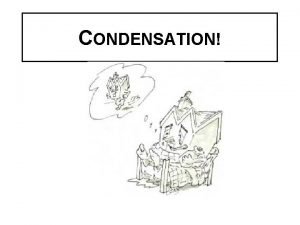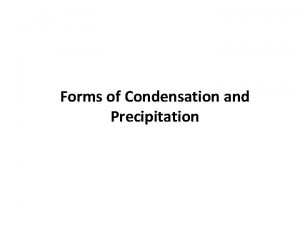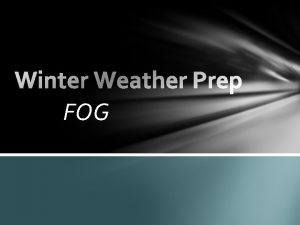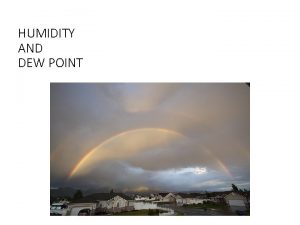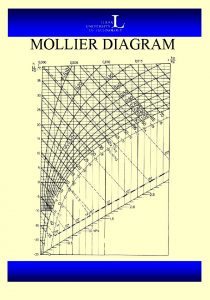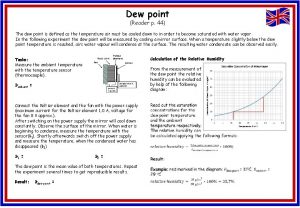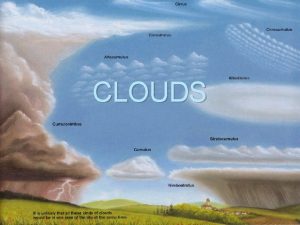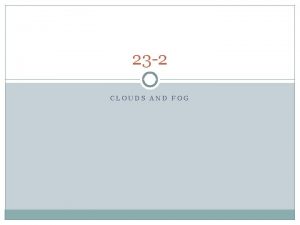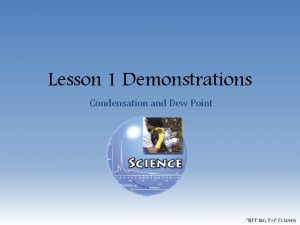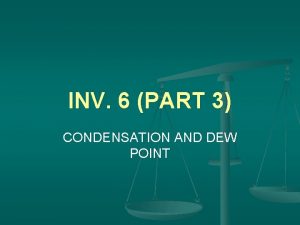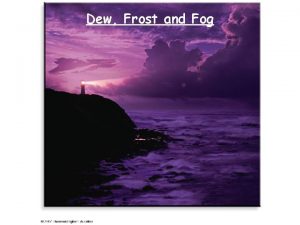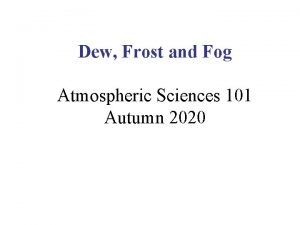Chapter 5 CONDENSATION DEW FOG CLOUDS The Formation
























































































- Slides: 88

Chapter 5 CONDENSATION: DEW, FOG, & CLOUDS






The Formation of Dew & Frost Dew forms on objects near the ground surface when they cool below the dew point temperature. More likely on clear nights due to increased radiative cooling White frost forms when temperature cools below the dew point and the dew point is below 0°C

FIGURE 5. 1 Dew forms on clear nights when objects on the surface cool to a temperature below the dew point. If these beads of water should freeze, they would become frozen dew.

FIGURE 5. 2 These are the delicate ice-crystal patterns that frost exhibits on a window during a cold winter morning.

Condensation Nuclei Particles suspended in the air that around which water condenses or freezes. Hydrophobic- water repelling, (oils) Hygroscopic- water seeking, (ocean salt)

HYDROPHOBIC HYGROSCOPIC (Ag. I)






FIGURE 5. 3 Hygroscopic nuclei are “water-seeking, ” and water vapor rapidly condenses on their surfaces. Hydrophobic nuclei are “water- repelling” and resist condensation.

Haze Dry condensation nuclei (above dew point) reflect and scatter sunlight creating bluish haze. isoprene oils Wet condensation nuclei (75% relative humidity) reflect and scatter sunlight creating grayish or white haze. salts



Fog Saturation reached condensation forms a cloud near the ground Radiation fog: clear nights, ground cools through conduction and radiation; ground fog Valley fog created by cold air drainage, usually in or near a river valley High inversion fog- slow warming of the ground burns from the ground up.


Radiation fog nestled in a valley

Visible satellite image of dense radiation fog in the southern half of California’s Central Valley on the morning of November 20, 2002. The white region to the east (right) of the fog is the snowcapped Sierra Nevada range. During the late fall and winter, the fog, nestled between two mountain ranges, can last for many days without dissipating. The fog on this day was responsible for several accidents.

Fog Advection Fog: warm moist fog moves horizontally (advects) over a cool surface. Summer fog on the Pacific coast Observation: Headlands Air converges and rises over headlands forming fog as compared to lower elevation beaches. Pg. 117




FIGURE 5. 7 Advection fog forms as the wind moves moist air over a cooler surface. Here advection fog, having formed over the cold, coastal water of the Pacific Ocean, is rolling inland past the Golden Gate Bridge in San Francisco. As fog moves inland, the air warms and the fog lifts above the surface. Eventually, the air becomes warm enough to totally evaporate the fog.

FIGURE 5. 9 (a) Radiation fog tends to form on clear, relatively calm nights when cool, moist surface air is overlain by drier air and rapid radiational cooling occurs. (b) Advection fog forms when the wind moves moist air over a cold surface and the moist air cools to its dew point.

Fog Upslope Fog: moist air flows up an orographic barrier East side of the Rockies Evaporation Fog: Warm moist surface provides enough moisture to saturate a dry air parcel; short lived ○ Steam fog ○ Breath in winter


UPSLOPE FOG


EVAPORATION FOG

FIGURE 5. 11 Even in summer, warm air rising above thermal pools in Yellowstone National Park condenses into a type of steam fog.

Foggy Weather In general fog not common for most location in the US. However several areas do exist with a high frequency of fog. Two causes: Elevation Ocean currents Cape Disappointment, Washington Avg. 2556 hrs per year

Average days of fog per year

Foggy Weather Environmental Issue: Fog dispersal Mix air with air craft or fans Introduce large particle into air to reduce total number of cloud droplets. Use dry ice to lower temperature below freezing.

Contrails condensation trails

A helicopter passes and mixes the dry air with the foggy air.

Clouds Classification of clouds: use Latin words to describe height and appearance. Factors described Height: low, mid, high, vertical Appearance: shape, density, color Stratus- layers or sheets Cumulus- puffy Cirrus- wispy like a lock of hair Nimbus-rain, dark, violent

Clouds form when humid air cools enough for water vapor to condense into droplets or ice crystals. The altitude at which this happens depends on the humidity and the rate at which temperature drops with elevation.


Approximate Height of Cloud Bases Above the Surface for Various Locations


High-Level Clouds High-level clouds form above 20, 000 feet (6, 000 meters) and since the temperatures are so cold at such high elevations, these clouds are primarily composed of ice crystals. High-level clouds are typically thin and white in appearance, but can appear in a magnificent array of colors when the sun is low on the horizon.

High Clouds Cirrus clouds- wispy



Cirrocumulus- rare, “a mackerel sky”


Cirrostratus clouds with a faint halo encircling the sun. The sun is the bright white area in the center of the circle.

Cirrocumulus are often associated with large weather systems. Cirrostratus (Cs) Cirrostratus clouds can cover part or all of the sky.

Mid-Level Clouds The bases of mid-level clouds typically appear between 6500 to 20, 000 feet (2, 000 to 6, 000 meters). Because of their lower altitudes, they are composed primarily of water droplets, however, they can also be composed of ice crystals when temperatures are cold enough

Middle Clouds Altocumulus

Altocumulus clouds are part of the Middle Cloud group (2000 -7000 m up). They are grayish-white with one part of the cloud darker than the other.

Altostratus clouds. The appearance of a dimly visible “watery sun” through a deck of gray clouds is usually a good indication that the clouds are altostratus.

Altostratus belong to the Middle Cloud group (2000 -7000 m up). An altostratus cloud usually covers the whole sky and has a gray or bluegray appearance.

Low-level Clouds Low clouds are of mostly composed of water droplets since their bases generally lie below 6, 500 feet (2, 000 meters). However, when temperatures are cold enough, these clouds may also contain ice particles and snow.

Low Clouds The nimbostratus is the sheetlike cloud from which light rain is falling. The ragged-appearing clouds beneath the nimbostratus is stratus fractus, or scud.

Nimbostratus clouds are also found below 2000 meters. They are usually a darker color of gray than stratus clouds because of their high moisture content

Stratocumulus clouds forming along the south coast of Florida. Notice that the rounded masses are larger than those of the altocumulus.

Stratocumulus Cloud (covering-mass): These clouds are characterized by their large dark, rounded masses, usually in groups, lines and/or waves.

A layer of low-lying stratus clouds hides these mountains in Iceland.

Stratus clouds are low to the ground. They come in layers and look like a gray blanket

Vertically Developed Clouds Probably the most familiar of the classified clouds is the cumulus cloud. Generated most commonly through eithermal convection or frontal lifting, these clouds can grow to heights in excess of 39, 000 feet (12, 000 meters), releasing incredible amounts of energy through the condensation of water vapor within the cloud itself.

Vertical Development Cumulus clouds. Small cumulus clouds such as these are sometimes called fair weather cumulus, or cumulus humilis.

Cumulus clouds are the lovely, puffy ones that are good for finding shapes in. These clouds occur in many varieties of atmospheric conditions

Cumulus congestus. This line of cumulus congestus clouds is building along Maryland’s eastern shore.

cumulonimbus cloud (thunderstorm). Strong upper-level winds blowing from right to left produce a well defined anvil. Sunlight scattered by falling ice crystals produces the white (bright) area beneath the anvil. Notice the heavy rain shower falling from the base of the cloud. Hail Producing Clouds

Some Unusual Clouds Not all clouds can be placed into the ten basic cloud forms. Unique atmospheric processes and environmental conditions create dramatic and exotic clouds. Unusual clouds and weather balloons often cause of UFO reports.


LENTICULAR CLOUDS

MAMMATUS CLOUDS

NOCTILICENT CLOUDS “night shining”

FRACTUS

Calvus

Scud Clouds Scud clouds are low, ragged and wind-torn cloud fragments, usually not attached to the thunderstorm base. They are often seen in association with, and behind, gust fronts. Scud clouds DO NOT produce severe weather. Scud clouds are often mistaken for wall clouds and tornadoes, especially when attached to the thunderstorm base.

Cloud Observations Sky conditions: cloud coverage divided into eighths and each amount associated with term such as scattered clouds. Observations: cloud ceilings Ceilometer used at airports to determine height from clouds by light or laser striking clouds and then amount and speed of reflected light recorded.


Cloud Observations Satellite Observations Geostationary, polar orbiting Visible light provides a black and white picture of clouds Infrared approximates cloud temperature which infers height Satellites measure many other variables: sea surface temperatures, ozone, upper level features, snow cover, land cover

The geostationary satellite moves through space at the same rate that the earth rotates, so it remains above a fixed spot on the equator and monitors one area constantly.

Polar-orbiting satellites scan from north to south, and on each successive orbit the satellite scans an area farther to the west.


Fig. 5 -35 b, p. 135


 What clouds have the greatest turbulence
What clouds have the greatest turbulence Difference between fog and dew
Difference between fog and dew Dew fog
Dew fog Fog types aviation
Fog types aviation Vertical
Vertical Advection fog vs radiation fog
Advection fog vs radiation fog Formation cloud
Formation cloud Formation initiale vs formation continue
Formation initiale vs formation continue High eggs hearse sized hay lee
High eggs hearse sized hay lee Why does dew form
Why does dew form Relative humidity reference table
Relative humidity reference table Bubble point calculation
Bubble point calculation Macbeth act five scene five
Macbeth act five scene five I have a little shadow that goes in and out with me
I have a little shadow that goes in and out with me Dew point
Dew point David robert dew
David robert dew Dew point temperature definition
Dew point temperature definition Dew point comfort chart
Dew point comfort chart Crafting the brand positioning
Crafting the brand positioning Consumer desirability criteria for pods
Consumer desirability criteria for pods Mountain dew teeth
Mountain dew teeth Jamie has enough money to buy either a mountain dew
Jamie has enough money to buy either a mountain dew Bergeron process
Bergeron process Localized convective lifting definition
Localized convective lifting definition Hát kết hợp bộ gõ cơ thể
Hát kết hợp bộ gõ cơ thể Bổ thể
Bổ thể Tỉ lệ cơ thể trẻ em
Tỉ lệ cơ thể trẻ em Gấu đi như thế nào
Gấu đi như thế nào Tư thế worm breton là gì
Tư thế worm breton là gì Hát lên người ơi
Hát lên người ơi Các môn thể thao bắt đầu bằng tiếng chạy
Các môn thể thao bắt đầu bằng tiếng chạy Thế nào là hệ số cao nhất
Thế nào là hệ số cao nhất Các châu lục và đại dương trên thế giới
Các châu lục và đại dương trên thế giới Cong thức tính động năng
Cong thức tính động năng Trời xanh đây là của chúng ta thể thơ
Trời xanh đây là của chúng ta thể thơ Mật thư tọa độ 5x5
Mật thư tọa độ 5x5 101012 bằng
101012 bằng Phản ứng thế ankan
Phản ứng thế ankan Các châu lục và đại dương trên thế giới
Các châu lục và đại dương trên thế giới Thơ thất ngôn tứ tuyệt đường luật
Thơ thất ngôn tứ tuyệt đường luật Quá trình desamine hóa có thể tạo ra
Quá trình desamine hóa có thể tạo ra Một số thể thơ truyền thống
Một số thể thơ truyền thống Cái miệng xinh xinh thế chỉ nói điều hay thôi
Cái miệng xinh xinh thế chỉ nói điều hay thôi Vẽ hình chiếu vuông góc của vật thể sau
Vẽ hình chiếu vuông góc của vật thể sau Nguyên nhân của sự mỏi cơ sinh 8
Nguyên nhân của sự mỏi cơ sinh 8 đặc điểm cơ thể của người tối cổ
đặc điểm cơ thể của người tối cổ Ví dụ về giọng cùng tên
Ví dụ về giọng cùng tên Vẽ hình chiếu đứng bằng cạnh của vật thể
Vẽ hình chiếu đứng bằng cạnh của vật thể Fecboak
Fecboak Thẻ vin
Thẻ vin đại từ thay thế
đại từ thay thế điện thế nghỉ
điện thế nghỉ Tư thế ngồi viết
Tư thế ngồi viết Diễn thế sinh thái là
Diễn thế sinh thái là Dot
Dot Bảng số nguyên tố lớn hơn 1000
Bảng số nguyên tố lớn hơn 1000 Tư thế ngồi viết
Tư thế ngồi viết Lời thề hippocrates
Lời thề hippocrates Thiếu nhi thế giới liên hoan
Thiếu nhi thế giới liên hoan ưu thế lai là gì
ưu thế lai là gì Hổ sinh sản vào mùa nào
Hổ sinh sản vào mùa nào Khi nào hổ mẹ dạy hổ con săn mồi
Khi nào hổ mẹ dạy hổ con săn mồi Sơ đồ cơ thể người
Sơ đồ cơ thể người Từ ngữ thể hiện lòng nhân hậu
Từ ngữ thể hiện lòng nhân hậu Thế nào là mạng điện lắp đặt kiểu nổi
Thế nào là mạng điện lắp đặt kiểu nổi Translation strategies and techniques
Translation strategies and techniques Evaporation condensation precipitation transpiration
Evaporation condensation precipitation transpiration Glycogen vs amylopectin
Glycogen vs amylopectin Condensation vs hydrolysis
Condensation vs hydrolysis 2 amino acids joined together
2 amino acids joined together Addition polymerization
Addition polymerization Phase change descriptions
Phase change descriptions Interstitial condensation definition
Interstitial condensation definition Capillary condensation
Capillary condensation Condensation reaction vs hydrolysis
Condensation reaction vs hydrolysis Enolate
Enolate Thiamine catalyzed benzoin condensation mechanism
Thiamine catalyzed benzoin condensation mechanism Intramolecular claisen condensation
Intramolecular claisen condensation Condensation cube
Condensation cube Condensation copolymers
Condensation copolymers Adiabatic liquid water content
Adiabatic liquid water content Solid to liquid endothermic or exothermic
Solid to liquid endothermic or exothermic Condensation evaporation melting freezing
Condensation evaporation melting freezing Condensation
Condensation What is the definition of homologous series
What is the definition of homologous series Mixed claisen condensation
Mixed claisen condensation Friedlander condensation
Friedlander condensation Water cycle transpiration
Water cycle transpiration


